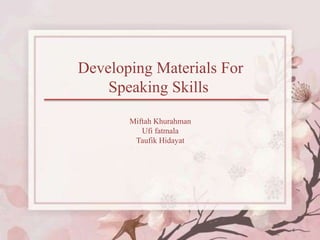
PPT PMD GROUP 13.pptx
- 1. Developing Materials For Speaking Skills Miftah Khurahman Ufi fatmala Taufik Hidayat
- 2. CONTENT • INTRODUCTION • OVERVIEW • A RATIONALE FPR EFFECTIE MATERIALS FOR SPEAKING SKILLS • EVALUATING MATERIALS FOR SPEAKING SKILLS • ASPECS THAT DESERVE MORE ATTENTION • CONCLUSION
- 3. OVERVIEW SETTING THE SCENE : SPEAKING SKILLS AND THE NEED FOR RELEVANT MATERIALS Speaking skills are best developed when learners learn to eventually take control of their own performance from an insider perspective (e.g. from the learners ), rather than being constantly dictated by external manipulation (e.g. by the teacher). Second language materials, as viewed by Tomlinson (2010,2011 ),should be created not only by writters but also by teachers and learners , in a creative process which stretches to the real classroom Teaching communication shouldbe seen as a proccess rather than a set of products (Tomlinson & Nunan )
- 4. OVERVIEW • METHODOLOGICAL TRENDS 1960S • The learning of linguistic systems • Structural Approach • Witnessed a ‘communicative revolution’ 1970S 1990S • Multidimensional syllabus • To build on a range of communicative criteria at the same time as acknowlwdging the need to proveide systematic pratice in the formal proprieties of the language’
- 5. OVERVIEW • TRENDS IN MATERIALS FOR SPEAKING SLKILLS STREAMLINE ENGLISH INTERCHANGE LANGUAGE IN USE Lesson 6 : A Nice flat (see figure 20.1) Student are asked to describe a room from a given picture. There is no freedom of choice and hardly any peer interaction involved in this task since all information comes directly from the same visual. Every learner performs the same role. Book 3, Activity ‘Same or Different?’ in Unit 12 (Richards, Hull and Proctor, 1991) students are provided with several sets of pictures depicting different object items and invited to discover how these items differ by asking each other questions. This activity utilizes the decoding and encoding of information gaps, which encourages students to exchange factual data. There is still no freedom of choice but at least learners are given the opportunity to interact for a purpose. There are two different roles to perform: information seeker and information provider. Activity 1 of Unit 3: Talking about Places (see Figure 20.2 ) invites learners to look at a picture of five different doors and imagine the rooms behind them. Since there are no right or wrong answers, students are encouraged to process meanings from their own experiences and perspectives. Besides providing freedom of choice, this material takes learners beyond the level of information gap into two new areas: reasoning gap, which involves deriving data by inference and perception, and opinion gap, which encourages personal feelings and attitudes.
- 6. A PROPOSD FRAMEWORK FOR DEVELOVING MATERIALS FOR SPOKEN LANGUAGE CONCEPTUALIZING LEARNER NEEDS Involving learners IDENTIFYING VERBAL COMMUNICATION STRATEGIES Designing tasks Practical devices TRANSLATING NEEDS TOSUBJECT MATTERE AND COMMUNICATION SITUATIONS UTILIZING VERBAL SOURCES FROM REAL LIFE Exercises Real life communication situations DESIGNING SKILLACQUIRING TASKS
- 7. A RATIONALE FOR EFFECTIVE MATERIALS FOR SPEAKING SKILLS • Effective materials for oral communication should enable learners to actively : 1.) Share and process information 2.) Control meanings, 3.) Choose how to participate, 4.) Utilize effectivity 5.)Utilize individual knowledge 6.) Become aware of ellipsis in spoken language, and 7.) Move beyon the initiation- Respond-Feedback model.
- 8. EVALUATING MATERIALS FOR SPEAKING SKILLS • Linguistic support -Do the materials provide appropriate and suffi cient Linguistic input? Do the materials help students get familiar with many Characteristics of spoken language? • Content-based and affective support -Do the materials satisfy learners with moments of inspiration, imagination, creativity and cultural sensibilities? Do the materials contain visuals that inspire and support verbal learning? • Skills support -Do speaking activities give students opportunities to both share and process information? Is the language presented and organized to effectively facilitate verbal discussion in chunks of speech? • Diversity and flexibility -Are the materials fl exible enough to serve more Than one type of learning style, profi ciency, maturity and interest? • Utilizing research trends -What view on methodology is implied in the materials and how does it refl ect recent SLA theories on speaking skills development ( see Burns and Hill,2013 ; Timis,2013)
- 9. ASPECTS THAT DESERVE MORE ATTENTION The Need ffor reflection of learner identity One important ingredient of high-quality materials as highted by Bassano and Christison (1987) is the opportunity for learners to remain themselves in the new language because being allowed to be who suggests, gives learners comfort in learning. The Need for Cultural Localization of Materials One way to check whether the materials are culturally appropriate and effective is to ask oneself such questions as : Will the learners be able to relate the content of the materials to their own situations and experiences in ways that are meaningful and interesting to them? What are the most significant issues in the society where our learners live? What are the most important values and beliefs embedded within their everyday life? Scholarly insight have been proposed for addressing the above problems
- 10. CONCLUSION The nature of communication reproduced in many current course materials is often far less complex than life, perhaps because simplifi ed language is easy to design Into activities that are easy to teach. However, it should be a never-ending responsibility of material writers To form a habit of reconsidering what has been written. Developing materials in a second language is an ongoing, long-term Process which involves strategizing in the writer’s offi ce, applying to Classroom action, and modifying on the grounds of real experiences and Real contexts of use. No matter how thoughtfully the material may be planned, it should be always open to some degree of writer-user interaction for further revision. This can be done by constantly observing Real-life situations, comparing them with our scripted materials to Highlight new features and new skills required for learners to operate more effectively in unpredictable communication.